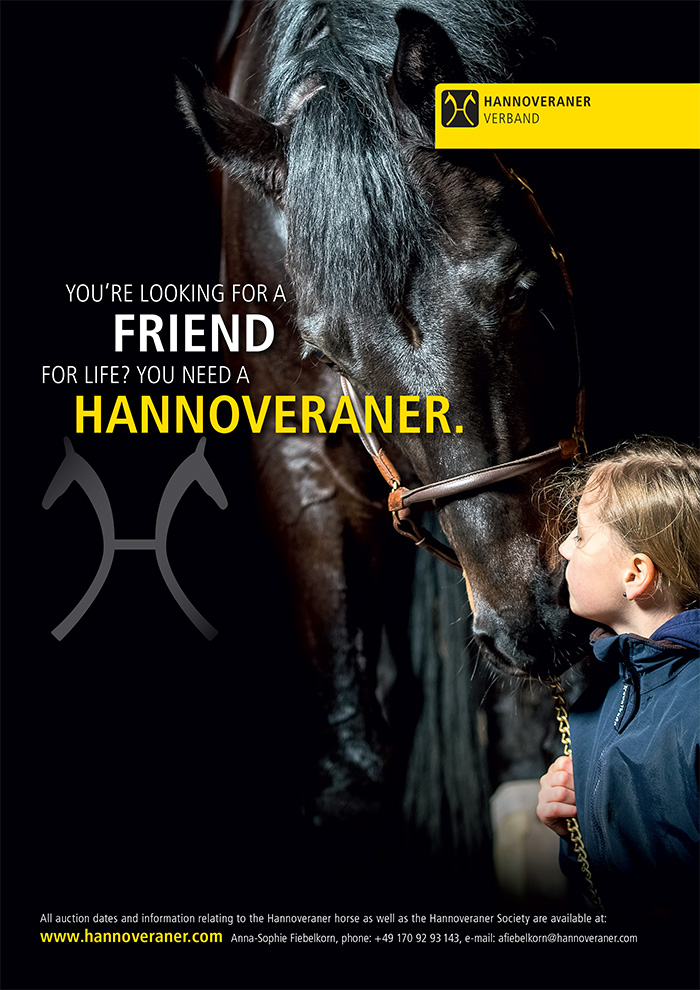 Story by Chris Hector and photos by Roz Neave and Dirk Caremans
Story by Chris Hector and photos by Roz Neave and Dirk Caremans
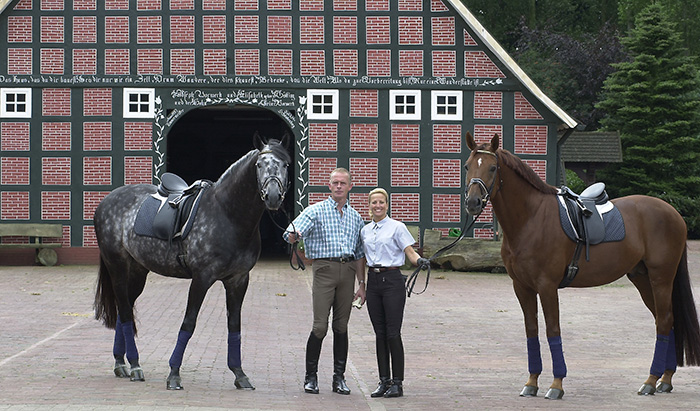
Ernst with Royal Diamond and Lisa with Relevant, both by Rubinstein
I must confess I love nothing better than sitting on the side of an arena, watching a really talented rider work really talented horses. This I guess is one of the reasons I kept visiting the Gestüt Vorwerk, back in the early 2000’s. Then under the leadership of Gudula Vorwerk-Happ, the daughter of the famed stud founder Georg Vorwerk, there was a uniquely talented collection of stallions – and the Lisa Wilcox in the saddle under the watchful eye of Ernst Hoyos f magic happened morning after morning in the big hall in the centre of the Oldenburg Stud.
Back thent the most successful dressage stallion in the world was the Rubinstein son, Relevant. ‘Relly’ was a mega-star at the 2002 World Championships in Jerez where he was a crucial contributor to the United States’ historic team silver medal placing. At Aachen the next year Relevant and Lisa were second in the Grand Prix (to Ernst’s other star pupil, Ulla Salzgeber with Rusty) with 73.54, and followed that up with a 77.04% in the Special and an 82.39% in the Freestyle.
Even working at home in the indoor school, Relevant has that something special. Right from the first trot out he is so soft, so easy in the snaffle. A little shoulder-in along the wall and into some big trot circles, then some short diagonals, holding back on the big trot, all the while demonstrating that extraordinary regularity of rhythm. Lisa gently taking Relevant’s nose to the inside:
“Just to loosen him, to get him off the inside rein, and have him light for the hand. To drop the neck and go to the hand and that he stay relaxed and over the back. To come with the neck and drop it, and relax those muscles,” says Lisa afterwards.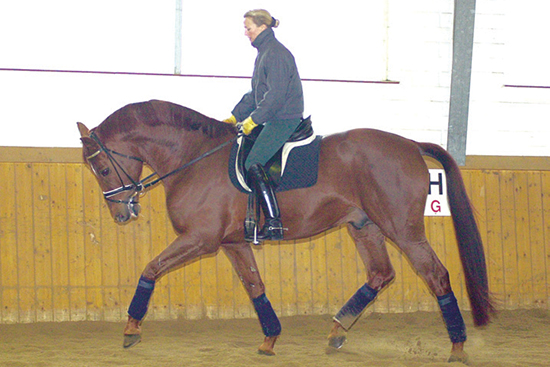
Into a perfect half pass, still exactly on the beat, and still in the same round soft outline. The pair are getting serious now, powering across the school in half pass, keeping the bend all the way to the wall.
more follows
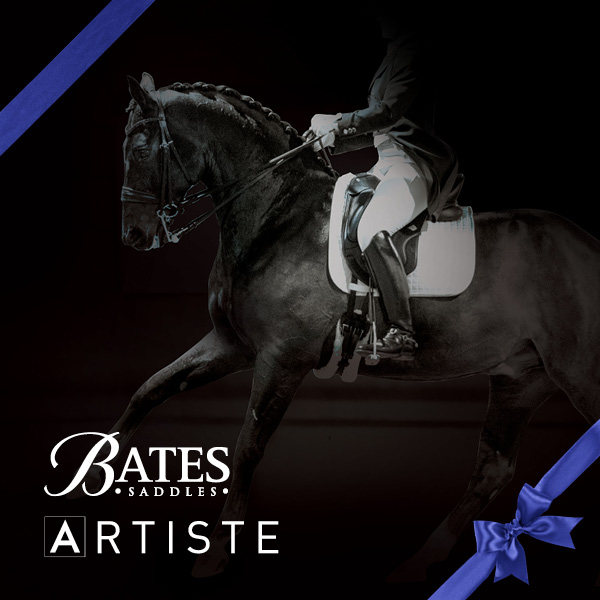
“I’m working on getting him to lower his neck. I want him to keep the neck at the correct length, where his head is at the vertical, but drop it and not get too short. I just want him to drop the neck and relax and work over his back before I got into the half passes. Instead of coming up and getting short in the half passes, I want him down and into the hand and over the back. If he gets short, that is when you start having rhythm problems. He has to keep going fluidly forward without losing the rhythm, and crossing over and staying parallel to the wall. These steep half passes are difficult, that’s why they ask for them in the Grand Prix.”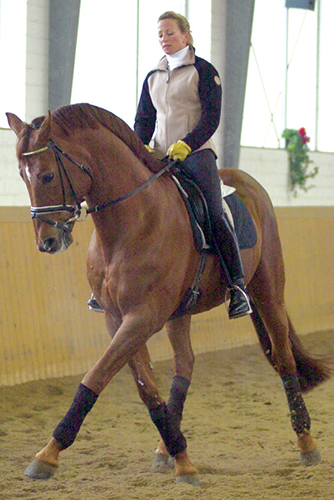
“I wanted to keep the neck low, stay relaxed, and over the back into the half pass. I was doing the same work in the canter, working on just getting him to drop his neck, staying bent laterally.”
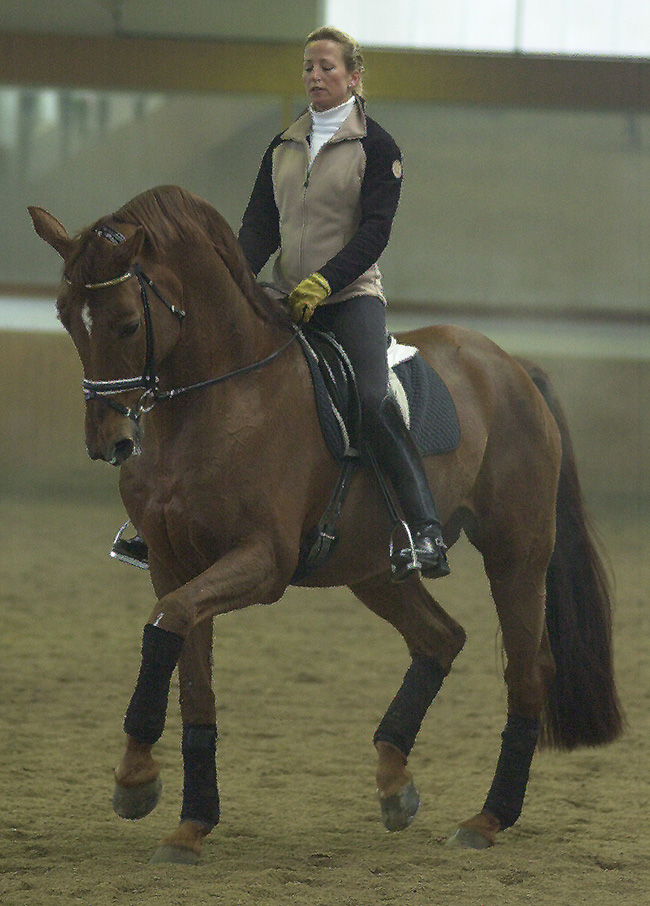
Into walk, and sweetly into passage, and the passage is getting slower, higher, more rhythmic, more expressive, every stride. A little relax in working trot (not that the horse has looked in the slightest put upon), a few steps more passage then into the most amazing piaffe. Right On The Spot! (It’s no surprise to learn that German judge, Volker Moritz, gave the pair a 10 for one of their piaffes at Aachen!).
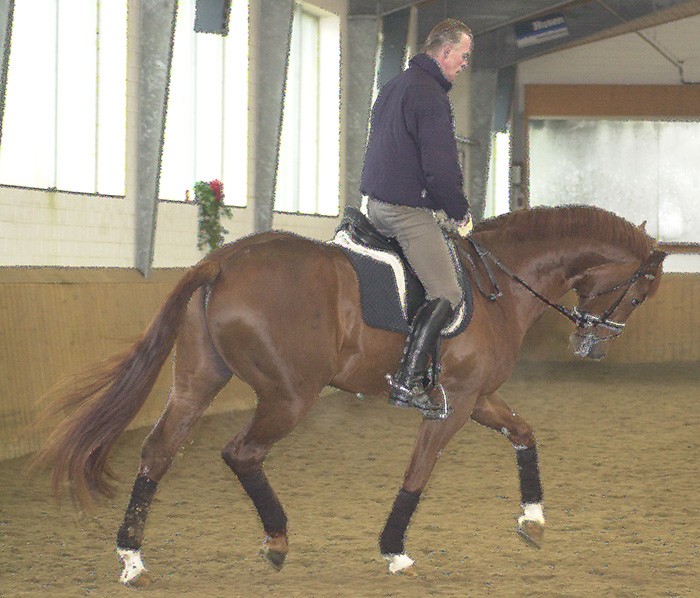
Lisa’s partner, and trainer, Ernst Hoyos is being more directive than usual, offering a running commentary from the back of the young Fidermark stallion, Feramo. “Be careful, sit, stomach forward and don’t collapse, make your upper body still but tall. Don’t collapse forward with the piaffe. Hold with the stomach and stay as still as you possibly can.”
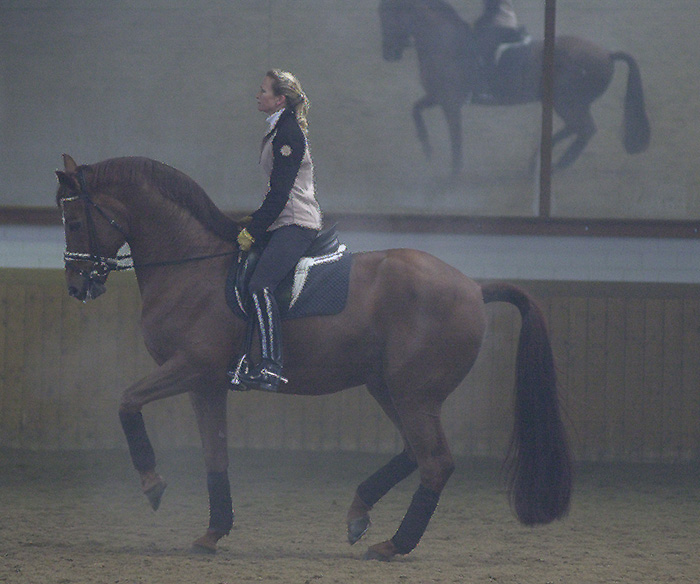
Lisa: “And my hands are going down, the lower my hands go, the lower he goes with his neck. And I want him to lower his neck in the piaffe. This is a whole new picture you are seeing with this horse as we progress into more harmony, more relaxed piaffe passage work, otherwise he goes too short in the frame – that’s why we work so much on getting him over the top line and through.”
more below
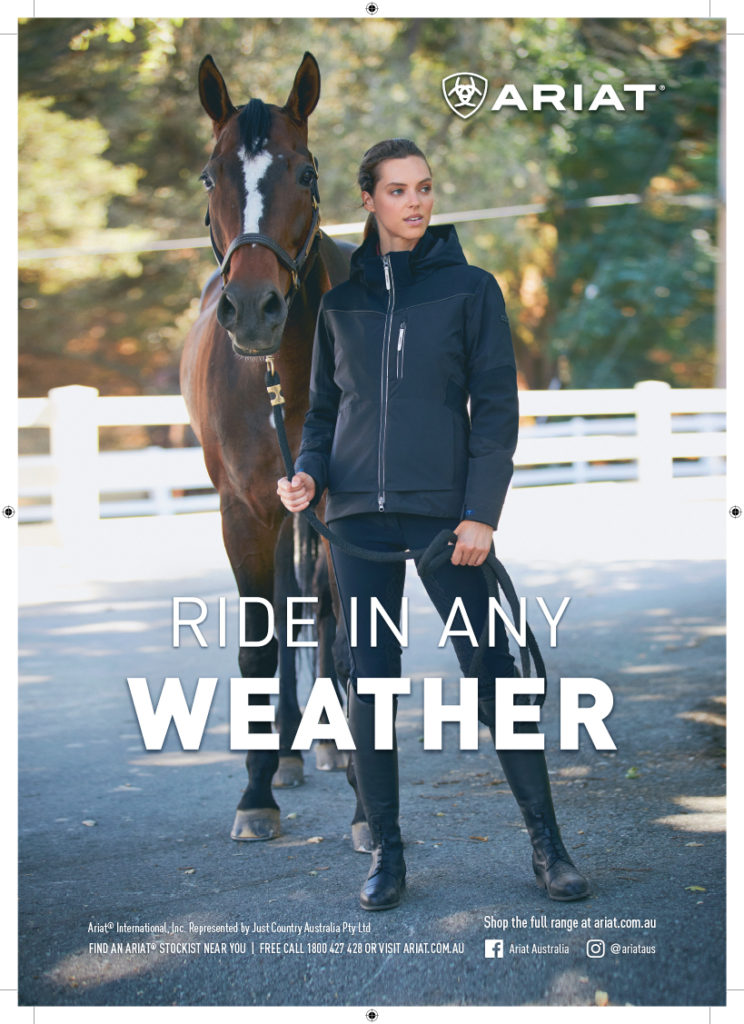
Out into passage, and the horse has got a bit tense, Lisa is holding the rhythm with her body, making it come, softer, slower, more even.
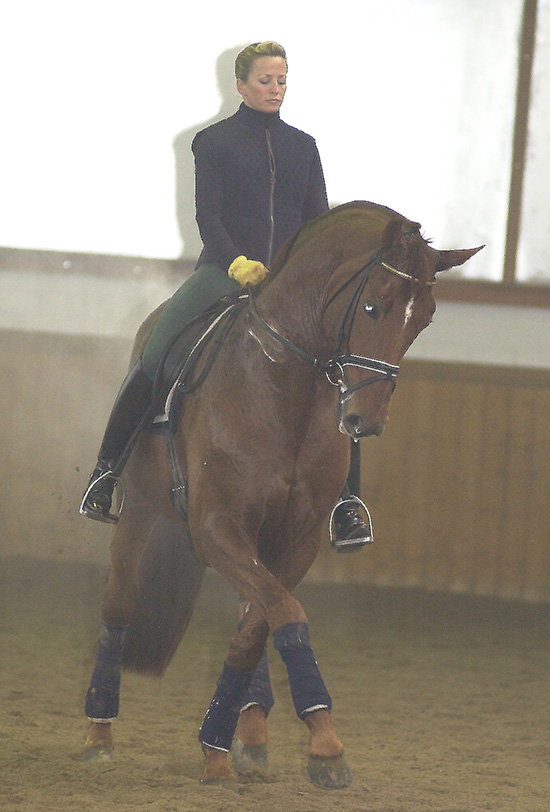
Ernst again: “Be more quiet with the leg, quiet with your outside hand. Make the half halt through the elbow and not with the hand. Close the elbow so it holds the beat, then you don’t get too much going – too much arm too much legs – because it is a critical moment. The half halt should come from the elbow, from stiffening the joint.”
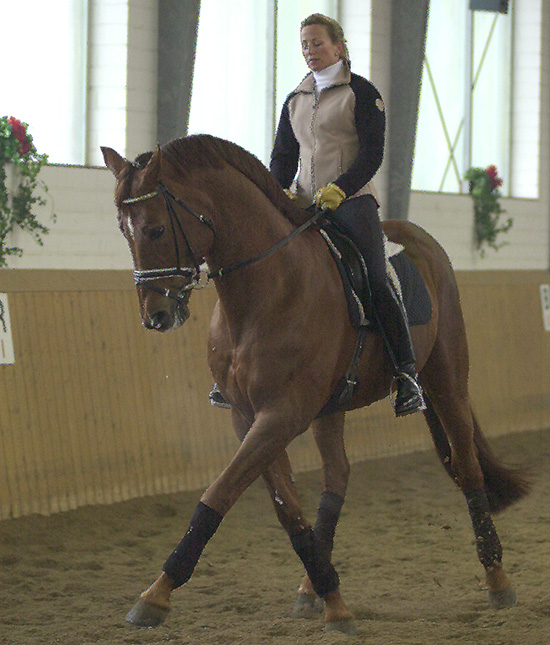
“If you make the half halts with the hand then the contact is too inconsistent because it is wiggling. If the half halt comes from the elbow it is more stable more here, then it goes automatically to the seat.”
“The connection to the bit through the outside rein has to stay steady, clear – any kind of wriggling with the wrist is going to break that connection. You keep the wrist quiet, keep your thumb up, your hand and fist, vertical. Take the half halt further back – your elbow is at your side, just above your hip. You have to remember that your stomach muscles are tense and holding. What you do is come through with the elbow, and when you come through with the elbow, you are already just above your seat. That carries the half halt to your seat. Think about the half halt starting that far back.”
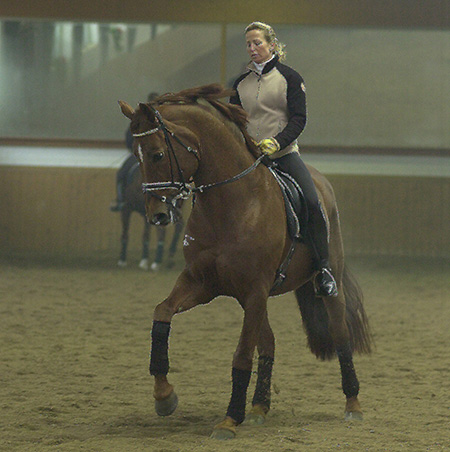
Into that wonderful Rubinstein canter, again Lisa softening Relevant’s neck with the little half halts to the inside. A couple of half passes then into counter canter…
“He wanted to change, and I noticed he was trying to get ahead of me. I would finish a half pass, and he would do the change without me asking. So to correct that, I don’t let him to do a change, we just do counter canter until he stops thinking ahead. You have to be careful, if they get too clever, they put the change in somewhere else. I just did the changes on the long side, the short side, anywhere, wherever I felt he was waiting for me and not doing it on his own.”
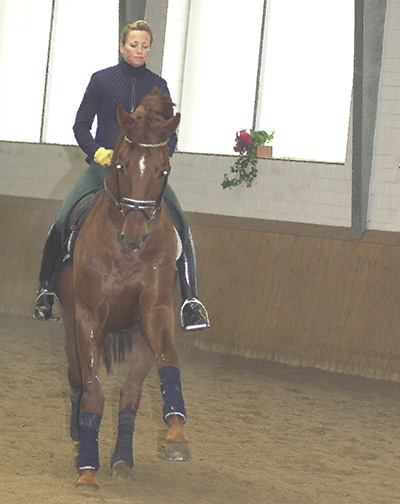
“He can be as intelligent as he wants to be, and I’m happy about that, but he still has to wait. If I allow him to keep doing that, I am going to have problems later, and you saw it in the one tempi, two tempi changes, he was doing everything all by himself, he was just getting wound up. So I went back to four tempi, went back to three tempi, did some pirouettes in between, to get him to forget it, and the last thing we did were some two tempi, and the only thing he did wrong was get a little bit fast. That’s okay, we pat him, and that was the session for today.”
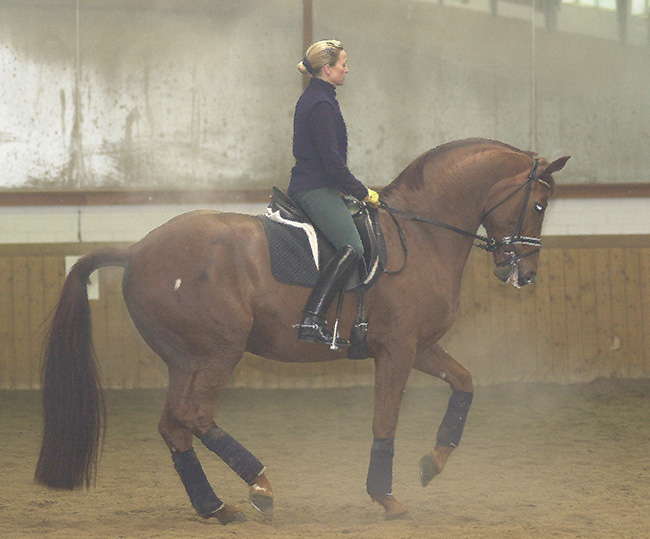
“He’s comfortable with the movements of Grand Prix now, it’s just a matter now of getting it more even in the transitions, in and out, just polishing the movements.”
next comes Royal Diamond, aka Roy the Boy
Royal Diamond – alias Roy the Boy – has started competing in the ultimate – Grand Prix. Lisa is in reminisce mode, recalling Roy’s appearance at the Bundeschampionate…
“He first went there when he was four and he was so little, compared with all the BIG boys like Lord Sinclair – but that was in 1998 and now he is ready to play!”
(In fairness to Royal Diamond it should be pointed out that he went on to take the six year old titles, while Lord Sinclair virtually disappeared after his 4 year old triumph. AND the other day, Roy went out in only his second Grand Prix Special to score a 69.5%!!!)
Sure enough Roy bounces out, bright as a button in working trot. Once again, Lisa is concentrating on keeping him round, making him go over the back, and as he comes deeper and relaxes his muscles, his hind legs come bigger, freer.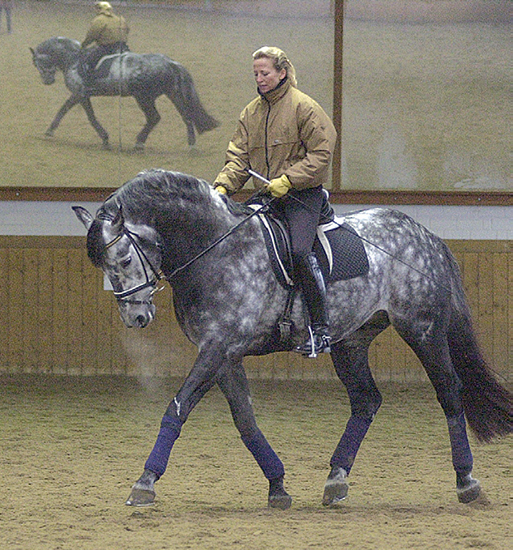
“My work with Roy the boy today was the same idea as Relevant. We want to get him to drop his neck, relax. He gets a little tight, he gets even more tight than Relevant gets, then he is like a spring board – and you have to sit on him, and he doesn’t take you, he makes himself a little tense. So I try to get him to drop his neck, stretch into the hand, and start to swing the top of his back. And you can see it by the end, he starts to take the weight and starts to go forward.”
“It’s a normal phase, especially now when they are allowed to start practising their piaffe / passage practically every day. It’s like the young horses with the changes, they have problems with the canter for a while, it’s normal. At the trot I just have to make sure I can get it relaxed and take a lot of time, I sit and I stay quiet, and it is just a matter of getting him to relax his muscles.”
“I can come from a half pass on the left hand and want to go to the right hand, and instead of letting go, he holds on to that rein. It is especially now, when the work is different, it is more intense, his head is going ‘oh boy, what’s coming now, what’s coming now…’”
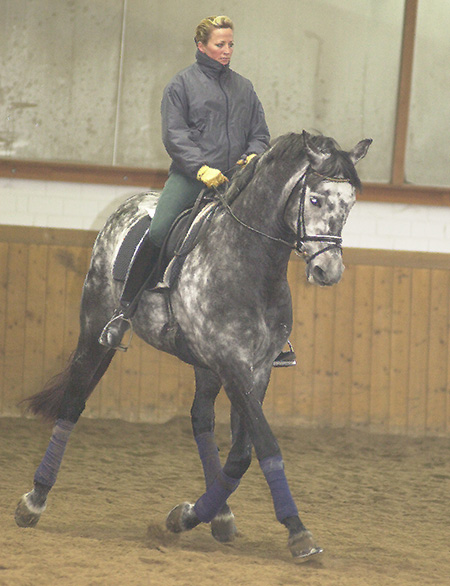
Lisa is riding lots of shoulder-in down the quarter line, and Roy wants to squirm out of the bend. Lisa just sits and rides him into it. At this point I notice that Lisa has the full 360-degree rotate of her pony tail happening. No doubt some Alexander Method guru will know if there is any huge significance in the fact that it looks as if it goes clockwise on the left rein, straight up and down on the centre line and anti clockwise on the right rein. Surely there is a keen graduate out there looking for a post-grad thesis topic?
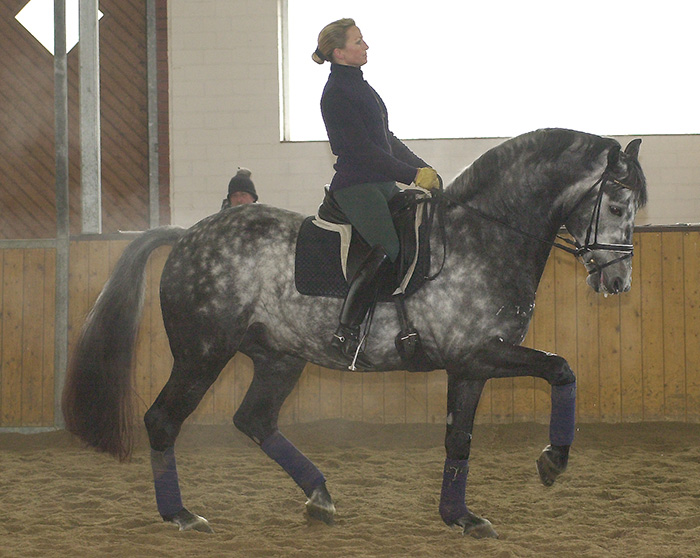
Still on the quarter line, Lisa is riding the grey stallion into passage and Roy gets a little all over the place, but once again, Lisa sits quiet, persists and gets her passage. It is the same in piaffe. A bit of an explosion and a kick up behind, and Lisa just sits there, and sure enough piaffe comes. Roy gets a bit excited, loses the piaffe, then gets it again.
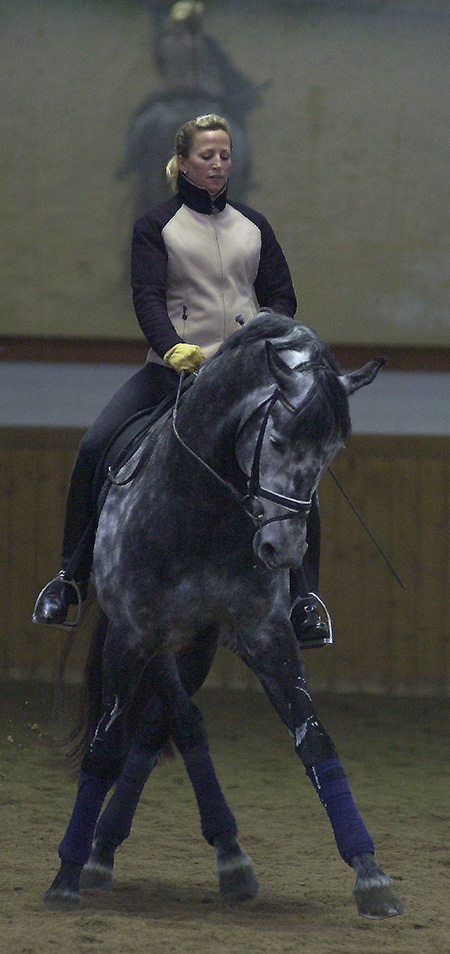
With some of that excess energy worked off, Roy is moving lower, softer in the half pass, really flowing along the short diagonal, still with super bend and rhythm. Into some big canter circles in shoulder-in position, making him take the weight on the inside hindleg, round in the shoulder-in until he gives and takes the bend and the tempo. He, like Relevant before him, thinks it might be cuter to toss in a change instead of all that hard work going through the corner in counter canter, and like Relevant he learns that perhaps counter canter is what is being asked after all. Once again, Lisa puts Roy’s neck deep in the canter to loosen him for the pirouette work, and canter pirouettes are another thing Roy can do really well.
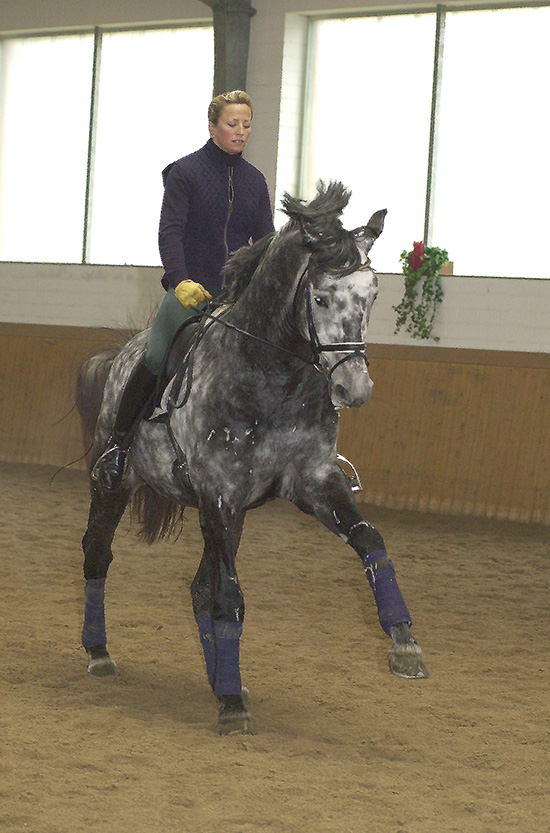
“He ended up super, really nice and moving and swinging in the back – I am just getting him to swing in the back with these exercises.
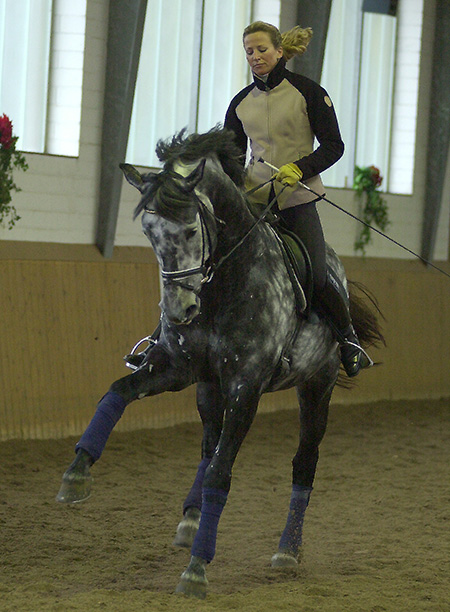
When the horses are coming up through the grades, and learning all these things, especially a horse like Roy, where he thinks a lot about what could be coming up, what did he do before, then because he is anticipating, he’ll try and tense himself in the movements – I have to be ready for that and keep him loose and swinging in his back. Between the exercises, get him loose again, start up again – whereas Relevant is such an old professional he’s now staying loose through all the movements – it’s just a matter of maturing physically.”
“First of all it is like ‘ok I’m doing passage and I am really tight about it’ – Relevant also went through this phase, now Relevant starts to swing through the body through all the exercises from the piaffer to the passage into the piaffer again and he maintains this elasticity and swinging back with basically the same contact. Roy is moving around a lot looking for the contact, you might not see it, but you can really feel it with the young horses, they are looking for somewhere to hold on to, and I’m trying to keep him from wanting to take that inside rein. As Roy is maturing physically, you see he doesn’t quite have the strength all the time, to hold the movement in its entirety – the whole length of the arena, or the 15 steps of the piaffe.”
“ You’ll see him looking for a place to balance himself. I have to keep him from wanting to take that rein that he wants to hang on to, to balance himself. I have to be very careful in my softening aids, so I don’t disrupt the movement. But if I feel him start to fall on to the hand because he hasn’t got the strength to carry it through, if I don’t start to soften and even it out on the other rein, I am going to have a rhythm mistake. It is my job as rider to try and keep those connections as even as possible.”
“Roy is a totally different personality to Relevant. Roy is a real macho, he does what he has to do which is absolutely okay, as long as the work gets more clear and expressive as we go. OK in piaffe passage I always have to work on that right hind leg, sometimes that is also my fault. I’m blocking. When I let go with that right rein he starts coming through.”
“But it is just a struggle to keep that even contact all the way through the transitions, into the movement, and maintaining it – that’s a long passage these days. Circle left, straight piaffe, circle right straight, halt – that’s a lot of passage and it has to be one entire ten metre circle and for that you need perfectly even contact. That’s what I’m working on, getting him to drop his neck and really maintain nice easy contact. And every now and then it helps, that quick ‘soften’ with the inside rein. But I have to be careful, I don’t want him to get back behind the contact, just so he lets go.”
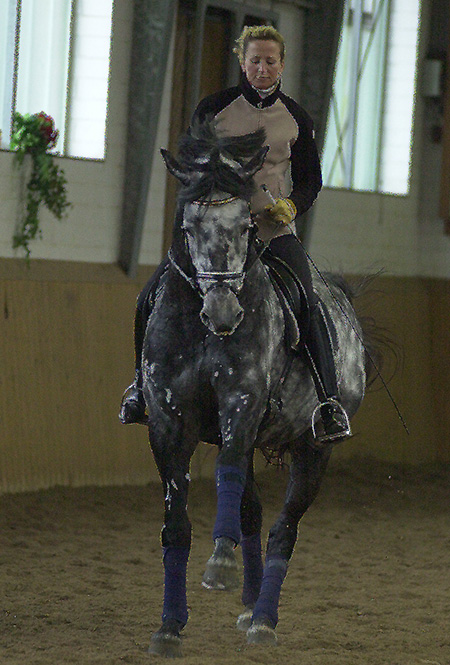
“It is really important to get him to relax over the top line. You can see he is just thinking one tempi right now. To relax over the top line and listen to me, so he doesn’t just close up the topline and do his thing. That closing is just not letting me sit in him. When he relaxes and lets me in, and stays in front of me, and he takes my weight, and accepts and waits for my aids, that is how it should be, but right now all he can think about is one times changes. We’ve been doing one times for two months now, and of course he could just do them, for Roy no problem.”
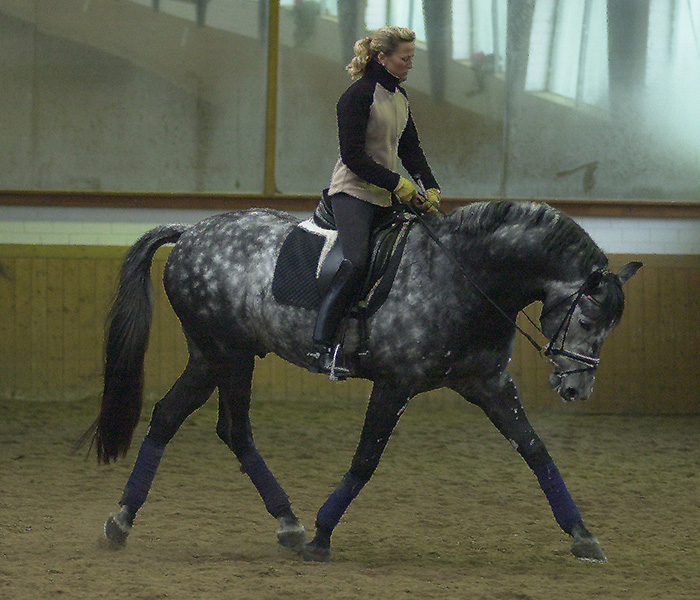
“He is so smart, he is so darned smart. That is the problem with Royal Diamond. I have not done one times with him for over one year because he was doing the same thing, mixing the ones times in with the other tempi changes. That’s okay, having a horse that is so clever is almost a weakness, unless you are ahead of the ball game, unless you can be ahead of him.”
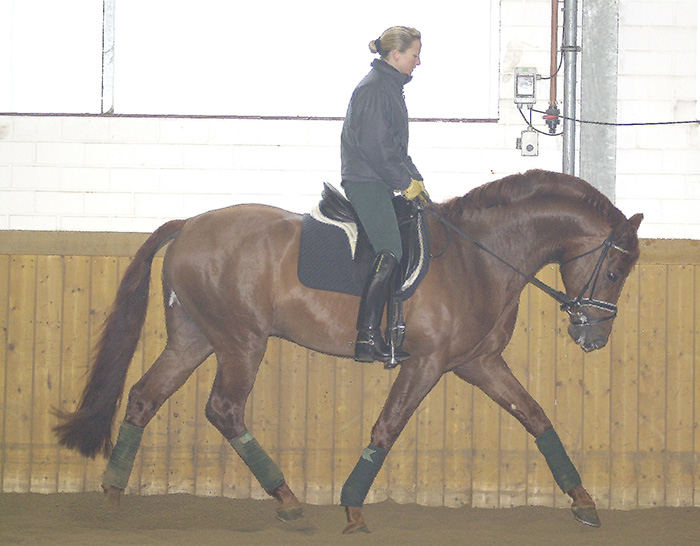
If Roy the boy is something of a smarty, Revan – who is Relevant’s younger full brother – is just so sweet, so young and happy to oblige. The trot is perhaps just a bit too fast and I ask Lisa, if this doesn’t bother her:
“I don’t worry so long as it is not too way over-tempo. The rhythm is important. That’s the Rubinsteins, they start out with a Mickey Mouse trot and when they are strong and balanced, and can carry themselves, they have it. Especially when they are going through growing phases, like Revan is now, they have problems balancing themselves. I find the Rubinsteins get to the end of their five-year-old year, beginning of the six-year-old year, then they really start to trot and they are not too fast then. I think it must be the growing phase because Revan is sensitive all over his body, super sensitive to the leg – he’s even ticklish when you take his rug off.”
“With Revan right now it is just a matter of building up strength, straightness, physically working through the training scale. He is forward, he is even on the hand. I’m building up the strength of his hindlegs at the moment, that he closes them, not getting wide behind in the extensions.”
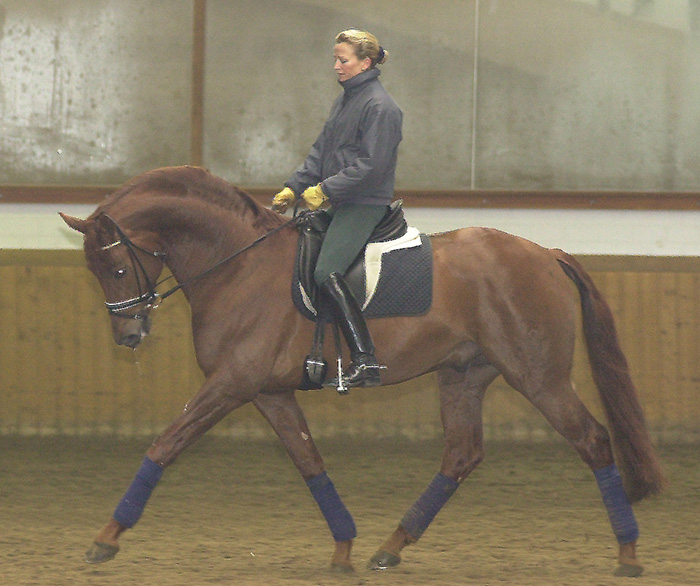
“I just play with the extensions, in a shoulder fore position – but still it is a matter of building it up. It is very difficult for them to hold that at this age, and they get out of balance, and try to find their balance on your hand. So you have more in the hand, and you are trying to hold the shoulder fore position so that they track closer together with their hindlegs and not wide.”
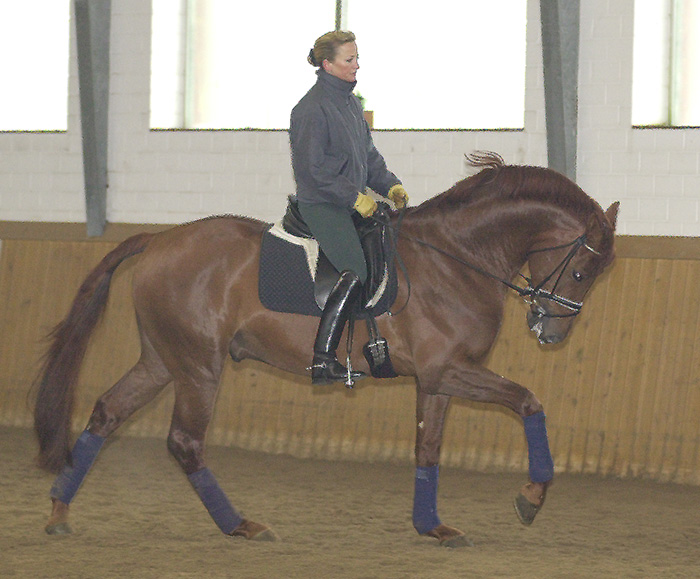
“You can also do this in canter, in shoulderin, and transitions, a little bit collected, let him go forward, then a little bit collected, let him go forward. Remember we are talking young horse collection, it’s not extreme collection, it is just bringing him back, stepping underneath themselves. Carrying themselves a couple of strides, then going forward back to the working gait. The exercises are strengthening exercises and slowly but surely they start to close in behind and become steady and strong enough, then they can go out in the extension without getting wide.”
“Often young horses get wide, it is not such a problem. A lot of the horses you see in the material classes at the Bundeschampionate go wide, they are just too young and they don’t have the strength to carry themselves. We are just building up strength, teaching him how to carry himself. The counter canter is coming into play slowly but surely. Lots of transitions, that’s what we are working on right now, and steadying up the contact in front – getting it so he stays more even, stays straight, doesn’t want to hang on one or the other rein to avoid having to carry himself.”
You don’t mind if he gets a little deep on you right now?
“No, that will change and vary. Sometimes he is just right, sometimes he tucks down and sometimes he is back up again. It just depends on the balance, when you lose your balance you are going to lose the frame right away, the more strength he gets, the more even he will become, but this is a completely normal phase. With most four year olds you can’t work on counter canter, it is just that he is so naturally balanced that you can try, and the counter canter helps make him even more balanced.”
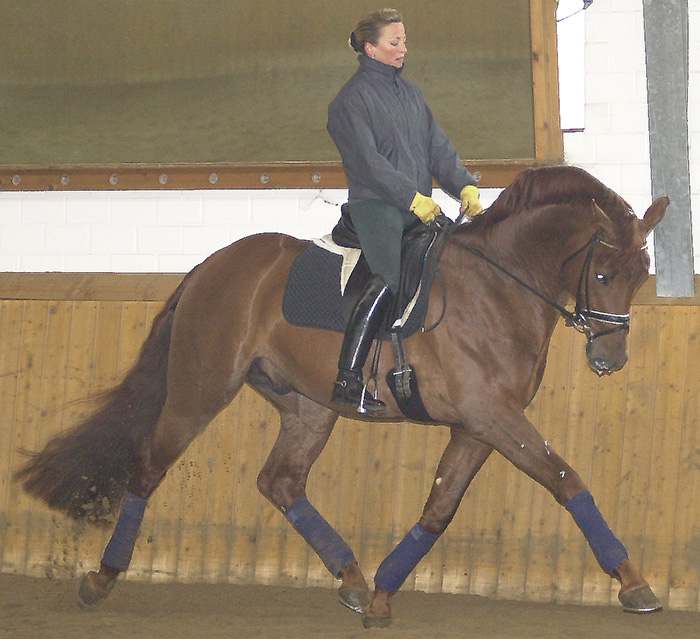
As he becomes more balanced, Lisa is able to give with both hands, showing a bit of uberstreichen – and Revan’s wonderful front lengthens, and you see how glorious his canter is. It is no wonder that the farmer who own his mother, now 24 years of age, is hoping to get her in foal to Rubinstein once again, after she missed last season.
Is he like his big brother?
“He is very like his big brother. He is more self-assured, whereas his brother can get a little overwhelmed by it all at times. They are very similar to work, very light aids, very sensitive, but I think Revan has a better natural walk. He relaxes from the beginning, where with Relevant, I have to relax him before he shows his walk.”
another Rubinstein son follows
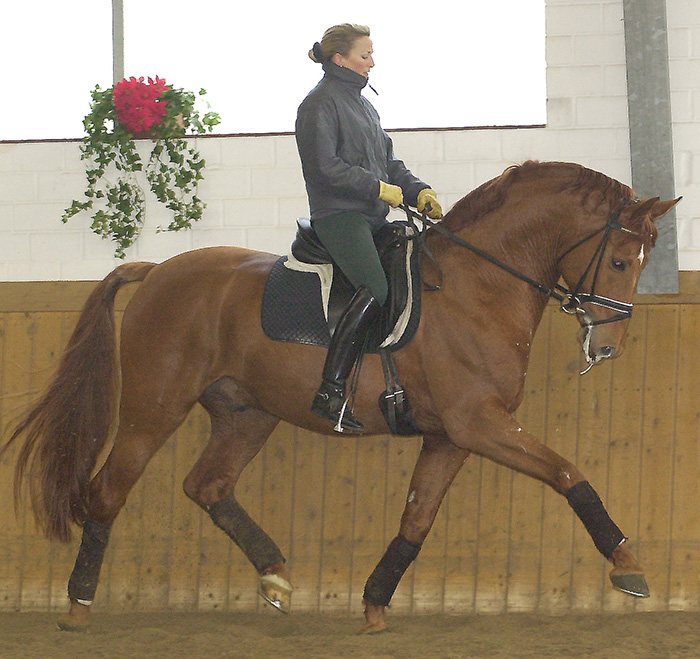
Raoul is one of my favorites at the Vorwerk barn, it has been so good to watch him mature from a gangly youngster just back from his performance test to an exciting riding machine. Raoul missed out on the Bundeschampionate last year when Lisa moved into the US team training camp in Spain in the run up to the WEG, but he’ll have his chance this year, and might just give them a run for their money. He just has to get a bit more settled in his flying changes. At the moment it is a matter of Lisa trying to find somewhere in the school to ask him for the change where the young stallion is not expecting it…
“We start with the flying changes right after they have done their five year old class at the Bundeschampionate, for that we want counter canter so we don’t confuse them. Now that I have started on the change what I am working on is the quality of the canter between the changes. You lose the quality of the canter once you start teaching changes, that is just because they are anticipating and they start getting tense – it can become a four beat, or a ‘hectic’. It is just a matter of getting them to relax in between the changes.”
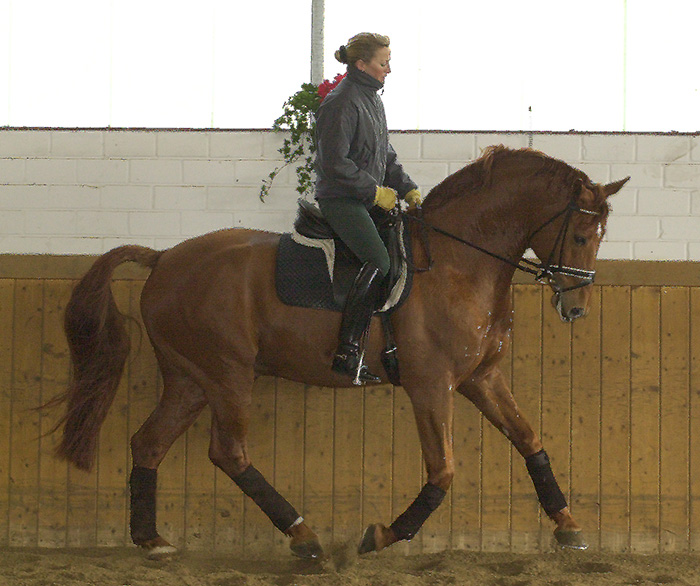
“I started today with a lot of canter work to get him relaxed because he is getting tight in the canter at the moment. Today you saw a lot of canter shoulder-in, shoulder fore, I want him to step underneath. Sometimes if I feel I am not getting the bend in his ribcage, then I do an extreme shoulder-in. Then when I feel I have him on the outside rein, and bending through the rib cage, you can feel the canter. You can see the change in the canter, it is round, relaxed, three beat.”
“Then it is a matter of thinking out places where he can’t pre-prepare for the change. I try a lot of things, like counter canter on the long side to a change. Or over the diagonal to a change and if I feel he is starting to lose the canter and take off, circle, start to get the bend again in the body, get him through again, and start over again.”
“In the end, you saw a mild medium canter, loose, no pressure whatsoever, then ask for the change. It has just been this week that I can do that. Before that I wouldn’t have had him round enough to give him this freedom in the flying change. The right one is extremely big, but that is also a problem – he is holding himself in the flying change when he needs to go forward in the changes. Get it so it is like a step in the air. I want him that big, but still to go forward, and that is why I started the medium canters, to get him to go forward. Get him to relax, and trick him a little bit, go across the diagonal, he’s thinking ‘change, change’ – no, no change, counter canter… It is just working on maintaining the quality of the canter in the making of the change. You will always find that with changes you lose that quality, this is completely normal, don’t get frustrated, it’s just a matter of tine before it becomes routine for them.”
“He can step that much further under himself, I’ve just got to encourage him to come underneath himself, but I am not going to throw away the outside rein, I want to maintain straightness but also really step underneath and not block.”
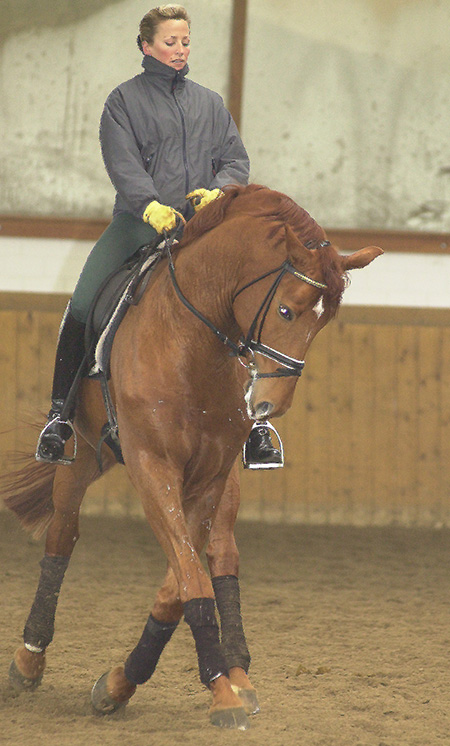
“I want to maintain straightness but I want him to step underneath himself, and I don’t want to block him so I am softening on the inside rein. I will give that inside rein and exaggerate it as long as I feel he is going to stay bent laterally. If you can give and they stay soft and bent to the inside, then it frees them up to step under themselves.”
“In softening up the inside it is the entire inside line from the ribcage to the hand, so that he lets go there, and when he is loose there, he can step to his full potential under his centre of balance.”
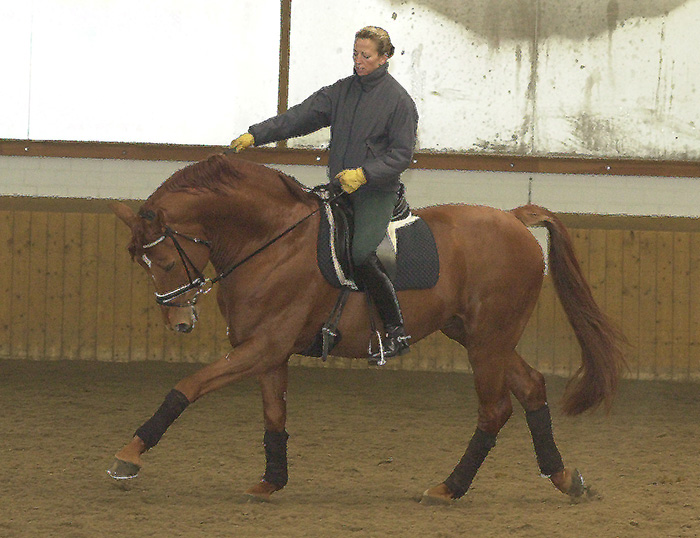
Raoul shows us he is taking more weight on his inside hind leg…
“When you give for that little moment in canter, it is feeling, it is knowing, that comes automatically. I am not even concentrating. The moment I do it, it is a feeling, ok, do it now. That’s something that is hard to teach, it is that second when you know, okay.”
Despite the fact that I am now frozen solid (this is notwithstanding two woollen jumpers, one woollen jacket, a woollen beanie and gloves and TWO horse rugs) it has been another wonderful day, and it seems like Lisa is pretty happy with the new set-up, sharing the riding with Ernst.
“Remember when you first came to visit, I was doing eight nine horses a day all by myself – now we start at ten and finished at three, this is much easier. I’ve got a bereiter, and I’ve got Ernst. Now I’m living like a queen.”
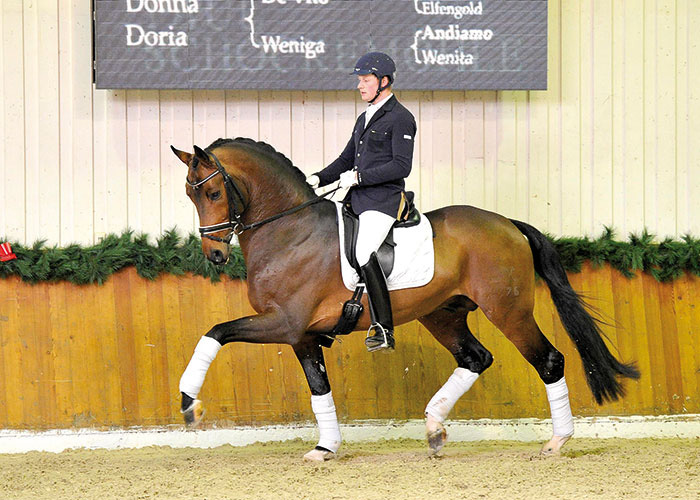
Want to breed y our own dressage star? Check out the super stallions available at International Horse Breeders https://ihb.com.au/product/foundation/



